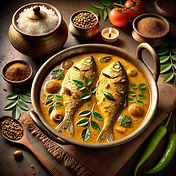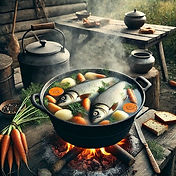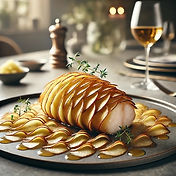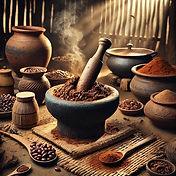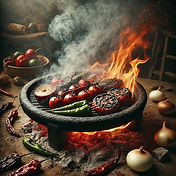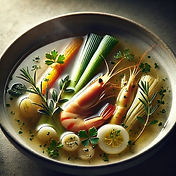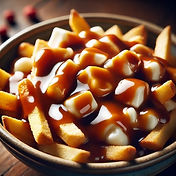Top Chef ™: Wisconsin
Season:
Week:
Chaos Cuisine

Guest, Matty Matheson: "All right, chefs, it's time to let loose and embrace chaos cuisine. Life is wild, right? How crazy can it get? Chaos is an amalgamation of ... 'Where did you come from? What have you learned? Where are you going? What's your culinary voice?' Chaos is every single day. My mind is just absolute chaos. I want you to do whatever you feel. Dream the biggest dream. I want you to take something, create it, destroy it. Build it up again. Throw it on the floor. Throw it up into the ceiling. Grab things. Use techniques you've never used before."
Kristen Kish: "I mean, I'm already confused. I'm so confused. We're going to clarify all of it for your elimination challenge. We want to see dishes that break the mold of culinary convention."
Chef Amanda: "I definitely think it's cooking without borders or limitations to marry cuisine styles together and just kind of bringing it all to the plate."
Kristen Kish: "To make sure that you all have fun with this challenge, you'll each have 20 minutes and $150 to shop at a specialty shop of your choosing. Tomorrow you'll be cooking right here in the top chef kitchen. So you'll have access to the entire top chef pantry. Good luck and happy shopping."

Get recipes ...
Subscribe to our weekly recipes and culinary tips from streamed cooking shows.
Dishes prepared in
Top Chef ™: Wisconsin
Chef Danny (during preparation): " The chou farci, it's incredibly rustic and hearty, but I'm using Japanese techniques. Really subtle, delicate flavors."
Chef Danny, presenting to judges: "I made for you a scallop chou farci with a yuzu kosho sauce. When were talking about chaos, I wanted to do something a little different with something really classic."
Chef Savannah (during preparation): " I'm doing a potato souffle, where you take two thin slices of potato and lay them on top of each other and fry it, and then it puffs up into a ball, and it's hollow on the inside. I've never done this before, so I want to test the technique and make sure that it puffs up the way I want. Oh, my God. The first one puffed. It's going to work!"
Chef Savannah (during preparation): "I need to blend my streusel, dust it on my puffs. I'm gonna fry them one more time. This is the riskiest dish I've made in this competition so far. But this is also the riskiest dish I've made in my career, period. I honestly can't believe this is working. If I fail this, then I will have failed this two times now, and I don't want to go home."
Chef Savannah, presenting to judges: "I made a potato souffle with golden milk, tropical fruit, and mustard greens. I wanted a chance to take all of that chaos and try to do it again in a more controlled, chaos way."
Chef Kaleena: " I made you a trash burrito. Inspired agnollotti with ancho chili and morita crema. So the idea is flavors of a burrito that I grew up on but also kind of transform it into a pasta dish."
Chef Rasika (during preparation): "I'm wrapping my eggplant with crab in it. I was going to sear the crab and eggplant, but instead I'm going to put it in the sous vide bath, so it's perfectly cooked, and it looks good."
Chef Rasika, presenting to judges: "First thing I thought about is pairing ingredients that you don't usually pair together. So I made crab and eggplant with mushroom conserva, some dukkah and garlic tahini."
Chef Dan: "I made an okonomiyaki funnel cake. We have lobster, crab, scallops, clams, shrimp, bacon. We have pickles, pickled fresnos, caviar, herbs. I just figured I might as well go for it."
Chef Michelle (during preparation): "Pitas can turn out dry, and so I need to make sure that my meat mixture is cooked nicely and that it's nice and moist when it arrives to the judges. 15 minutes on these."
Chef Michelle (presenting to judges): "A Vietnamese shrimp and pork areyas, puffed rice, herb salad, a little bit of sweet hoisin, and ginger.
Chef Kevin (preparing his dish): "I'm happy with how my potato turned out. It's very fancy for chaos. My definition of chaos is the big bang, so I wanted my dessert to look like an atom. It's gotta do the job."
Chef Kevin (presenting to judges): "When you say chaos, I thought 'big bang'. I thought, like, explosion. We have on the bottom, sweet mashed potatoes, lemon and vanilla. On the side is a little tarragon. Inside you have a capsule of a raspberry coulis with a white chocolate around."
Chef Manny, presenting to judges: "I always think that cooking is a metaphor for chaos. Mine is esquites risotto with a burnt tortilla aioli. The bitterness got balanced with the acidity of the lime and the fat on the mayo."
Chef Soo, presenting to judges: "This is General Soo's shrimp instead of chicken. I took shrimp and battered it using vermicelli noodles and little bit of chicken skin. Then the two sauces. The green one is the salsa verde, and then salsa roja mani.
Chef Amanda (preparing to judges): "I made a black garlic pappardelle with a cumin lamb ragu. On the very top is an XO sauce. There's also some celery leaf and crispy shrimp chips."
Chef Laura: "I'm going to crust the tahdig in ring molds. This dish, I serve it at my restaurant. People love it, and I call it Californian Tahdig."
Chef Laura (presenting to judges): "What I made for you is a tahdig. So it's a crispy Persian rice with Asian flavors. Yuzu kosho sauce, quail egg yolks, salmon seaweed salad on top. Mixing those two completely different ideas, that's the chaos that I wanted to create on the dish."
Culinary Challenges inspired by
Top Chef ™: Wisconsin
Meen Moilee is a celebrated Kerala fish curry that exemplifies South Indian coastal cuisine. This luxurious dish features firm white fish gently poached in a velvety coconut milk sauce infused with aromatic spices. The preparation begins by sautéing curry leaves, green chilies, ginger, and onions until fragrant, then adding turmeric, ground spices, and coconut milk to create a golden, creamy base. The fish is carefully added last, allowing it to cook just until tender. The hallmark of Meen Moilee is its balanced flavor profile - mild heat complemented by tanginess from tomatoes or sometimes vinegar, sweetness from coconut milk, and brightness from fresh lime juice. Served with rice, this curry represents the perfect harmony of Kerala's abundant seafood and tropical ingredients.
Ukha is a traditional Russian clear fish broth that dates back centuries, revered for its clean, delicate flavors. This aromatic soup begins by gently simmering whole fish—typically freshwater varieties like pike, perch, or sturgeon—with minimal vegetables and aromatics, allowing the pure essence of the fish to shine through.
The preparation is deliberately simple: fish, onions, carrots, bay leaves, black peppercorns, and occasionally potatoes or leeks. What distinguishes ukha is its clarity—the broth should remain transparent, never cloudy. Often finished with fresh herbs like dill or parsley and a splash of vodka, authentic ukha embodies Russian cuisine's philosophy of highlighting natural flavors rather than masking them with excessive seasonings.
Pommes de terre en écailles, meaning "scaly potatoes" in French, is an elegant potato preparation technique that transforms the humble tuber into a sophisticated side dish. Thin-sliced rounds of peeled potatoes are meticulously arranged in overlapping patterns resembling fish scales or roof tiles in a buttered dish. Each layer is brushed with melted butter and seasoned with salt and pepper before the next is added. The assembled potatoes are then baked until the edges turn wonderfully crisp while the centers remain tender.
The result is a visually striking dish with beautiful textural contrast—crispy, golden exterior scales protecting creamy interiors—that elevates any meal with its refined presentation and rich buttery flavor.
Dawadawa is a traditional West African fermented seasoning made primarily from locust beans (Parkia biglobosa), though occasionally from soybeans or other legumes. The preparation begins by boiling the beans until soft, then pounding them to remove the seed coats. The cleaned seeds are boiled again, spread out, and covered with leaves to ferment naturally for 2-3 days. This fermentation process develops a pungent aroma and complex, umami-rich flavor profile. The resulting black paste is typically shaped into balls or patties for storage. Used as a flavor foundation in soups, stews, and sauces across Ghana, Nigeria, and other West African countries, dawadawa adds remarkable depth and nutritional value to countless dishes.
You can buy dawadawa spice here.
Pipian is a rich, traditional Mexican sauce that exemplifies the complexity of pre-Hispanic cuisine. Made from ground pumpkin or squash seeds (pepitas), this velvety sauce incorporates various chiles, spices, and sometimes nuts or seeds like sesame or peanuts. The ingredients are toasted, ground into a paste, and simmered with broth until thickened to a smooth consistency. Pipian can range from vibrant green (pipian verde) to deep red (pipian rojo), depending on the chiles used. Commonly served over poultry or pork, this sauce offers a nutty, earthy flavor profile with subtle heat that showcases Mexico's remarkable ability to balance complex flavors into harmonious dishes.
Tatemado is a traditional Mexican cooking technique most commonly associated with Jalisco cuisine. This slow-cooking method involves placing ingredients—typically meat such as pork, goat, or beef—into clay pots that are partially buried in hot coals or placed in an underground pit oven. The pots are sealed with masa (corn dough) to trap moisture and smoke, allowing the meat to cook gently for several hours until incredibly tender. This process imparts a distinctive earthy flavor while preserving the meat's natural juices.
Tatemado dishes are often seasoned with regional spices, chiles, and herbs, creating complex flavor profiles that showcase Mexico's rich culinary heritage. The result is meltingly tender meat with unparalleled depth of flavor.
Nage, pronounced "nahj," is a fragrant, aromatic broth used in French cuisine primarily for poaching seafood and vegetables. This delicate liquid is typically created by simmering wine, water, or fish stock with aromatic vegetables (onions, celery, fennel) and herbs. After cooking, the ingredients may be strained out, and the remaining liquid can be reduced and enriched with butter to create a "beurre monté" sauce.
The term 'nage' is also used to describe dishes cooked in this liquid—referred to as "à la nage"—resulting in light, flavorful preparations that highlight the natural taste of the main ingredient while infusing it with subtle complexity.
Poutine: Quebec's Beloved Comfort Food
Poutine is a Canadian culinary treasure originating from Quebec in the late 1950s. This hearty dish consists of three essential components: crispy french fries, cheese curds, and rich brown gravy poured generously over the top, creating a delicious mess of contrasting textures and flavors.
The magic of poutine lies in its seemingly simple yet perfectly balanced combination. When done right, the fries remain crisp on the outside while soaking up savory gravy. The cheese curds, which must be fresh to achieve their signature 'squeak' between your teeth, soften slightly from the heat without fully melting. The gravy ties everything together with its savory depth. It is basically a roux, traditionally thickened with chicken or beef stock but a vegetarian option is just as good, with flavor from umami-rich mushrooms or earthy beets.
To create authentic poutine at home, begin with freshly cut potatoes, twice-fried for optimal crispness - first at a lower temperature to cook through, then at a higher temperature for that golden exterior. The cheese curds should be room temperature and as fresh as possible. Their slightly tangy flavor and distinctive texture cannot be substituted with shredded cheese. For the gravy, create a flavorful stock reduction, thickened to a consistency that coats the back of a spoon without being gloopy.
Assembly requires careful timing. The fries must be piping hot from the fryer, immediately topped with curds and quickly covered with steaming gravy that's hot enough to warm the curds but not so hot it melts them completely.
While traditional poutine remains a beloved classic, modern variations might include toppings like pulled pork, smoked meat, or even lobster. Whether enjoyed from a roadside stand in rural Quebec or prepared in your kitchen, poutine represents comfort food at its finest. it is unpretentious, indulgent, and deeply satisfying.
Soba Cha (also known as Soba-Cha and Sobacha) is Japanese buckwheat tea. It is drunk hot or cold, and is gluten-free and caffeine-free and apparently tastes nutty and slightly sweet.
It appeared three times in Top Chef: Wisconsin ™. The first showing was in Restaurant Wars when Danny's team, under his leadership, served up cold Soba Cha as a welcome drink. It wasn't well received.
In reparation, Danny re-introduced it in week 12 when he infused mushrooms into Soba Cha for his fish dish. This time, the judges regretted that he had buried the flavor of the buckwheat tea in very powerful mushroom flavors and would have preferred the essence of the tea to shine through.
Danny didn't try again, but Dan used Soba Cha in his Smoked Dashi and this time it went down a storm.
Hummingbird cake is a Jamaican banana and pineapple spiced cake which has been eaten in the southern United States since the 1970s. It is a leavened cake with a salty cake and often contains pecans.
Mofongo is a Caribbean dish originating in Puerto Rico and the Dominican Republic. Made by mashing ripe plantains with fat, garlic, spices, and (optionally) pork crackling, it is then shaped into a ball. The dish is famous for its complex and contrasting textures, with fried plantains that are crispy on the outside and soft on the inside. It is often found topped with melted cheese and served with a clear garlic broth.
Danny, in the 'spoiler' for the Top Chef Wisconsin Finale, was heard to say that he wanted to get fresh scallops for his first course and treat them in the style of "Leche de Tigre".
Leche de tigre, (translates to tiger's milk), is the Peruvian term for a citrus marinade that cures fish or seafood. Also known as leche de pantera, this marinade usually contains lime juice, onion, chile, and fish sauce.












